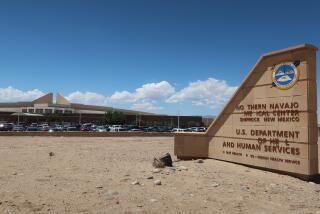Tracks of ‘Wolves’ Left in Ads Using Indian Imagery
- Share via
The success of the Oscar-winning film “Dances With Wolves” reflects renewed interest in American Indians, and, like other recent cultural phenomena, that interest is starting to influence mainstream advertising.
Indian themes and actors have appeared recently in ads for Japanese auto maker Mazda, fast-food chain Carl’s Jr. and long-distance telephone company MCI. And there seems to be growing interest in using such themes, said Yvonne Paradise, executive director of the American Indian Registry for the Performing Arts in Hollywood, which refers Indian actors.
“All of a sudden, after the Academy Awards, people walked in here with scripts,” she said last week.
It’s unclear how far the trend will go, some ad executives said. “Using borrowed interest like that tends to remind people more of the movie than it does the product,” said Bob Kuperman, president of Chiat/Day/Mojo’s Los Angeles office.
But for some Indian advocates, any interest is good for two reasons: It heightens awareness of American Indians as something more than a historical people, and it means jobs for an ethnic group plagued with high unemployment.
Indian themes are useful for products that want to convey an image of nature or environmental awareness or of the rugged West, ad executives said.
Still, Indian groups are sensitive about portrayals of Native American people for commercial purposes. Too often in the past, such marketing efforts have relied on offensive stereotypes of Indians as noble savages, princesses, squaws or fierce warriors.
Companies have also blithely appropriated Indian tribal names--such as Dakota, Cherokee or Winnebago--for product trademarks. Indian advocates argue that such practices exploit Indian peoples for commercial gain without permission or compensation.
There is some sign of heightened sensitivity among advertisers. When Mazda was launching its new sports utility vehicle last year, it seized on the name Navajo because of the connotations of nature and independence, said Larry Kopald, executive creative director for Foote, Cone & Belding/Los Angeles.
When the campaign was being developed, the Japanese auto maker took great pains to include the Navajo nation. Navajo consultants, actors and crew members were employed during shooting of a television commercial. Care was taken not to offend the Navajos when shooting at sacred sites or using religious imagery, Kopald said. In addition, the auto maker made donations to the nation and gave it one of the vehicles.
As a result, the Navajos did not object to the use of their tribal name on the vehicle or to the ad campaign used to sell it. “Normally, when you have a movie or commercial venture of this kind, there are often complaints among local Navajo people that they were not allowed to participate in employment or that perhaps damage was being done to the land,” said Duane Beyal, the Navajo tribal press officer. “With regard to the Mazda Navajo, we have not heard those kinds of complaints.”
Not everyone thought use of such themes was appropriate. One Indian rights advocate was offended by the use of sacred imagery. “It trivializes the religion,” said Tim Giago, publisher of the Lakota Times, a weekly newspaper aimed at the Lakota Sioux nation. “They would not think of trying to do that with any other religion.”
Ignoring such sensitivities can mean problems for advertisers. In the mid-1980s, Miller Brewing Co. received protests from Indian groups protesting the use of the word Dakota, the tribal name of one of the Sioux peoples, as the name of a new wheat beer. Alcoholism remains a serious problem among many Indian groups. Eventually, Miller decided not to market the beer nationally, though a spokesman said the controversy was not a reason.
More recently, the fast-food chain Carl’s Jr. drew criticism for wording used in a commercial that used some Indian imagery as part of a nostalgic evocation of the old Southwest designed to introduce the Santa Fe chicken sandwich.
The agency that produced the spot, Della Femina McNamee/Los Angeles, did not go to the extent that Mazda did to include Indians in the development of the ad, though permission was granted to film at the Laguna Pueblo in New Mexico and some Pueblo Indian non-actors were filmed.
One critic complained to television stations that the ad seemed to suggest that the chicken sandwiches were the last step in a process that began with the conquest of the Indians.
The commercial says in part: “If the Indians hadn’t taken a liking to a lonely desert plain, if Spaniards hadn’t come up the Chihuahua trail to conquer them, and if cowboys hadn’t got it in their heads to leave Missouri and move out West, there probably wouldn’t be any such thing as Santa Fe cooking and the spicy new Santa Fe chicken sandwich at Carl’s Jr.”
Carl’s agreed to alter the ad, and it now says: “If the Spaniards hadn’t come up the Chihuahua trail to find gold. . . . “
Indian advocates praise campaigns in which Indians appear as part of modern American society, not just as historical figures dressed in buckskins.
MCI includes one such portrait of a modern Indian family as part of its current campaign to promote its “Family & Friends” service. “We considered them to be part of the fabric of America,” said MCI spokeswoman Debra Shriver.
Use of American Indians in advertising has its perils, said Suzan Shown Harjo, a Cheyenne and Hodulgee Muscogee. “What ‘Dances With Wolves’ showed was that Indian themes mean money,” said Harjo, who is president of the Morning Star Foundation, an arts advocacy group in Washington.
But, she fears, “what we are going to see is is an overlayer of ‘Indian-ness’ on essentially Eurocentric presentations and products . . . and a sort of a further tokenizing of Indian people.”
More to Read
The biggest entertainment stories
Get our big stories about Hollywood, film, television, music, arts, culture and more right in your inbox as soon as they publish.
You may occasionally receive promotional content from the Los Angeles Times.










